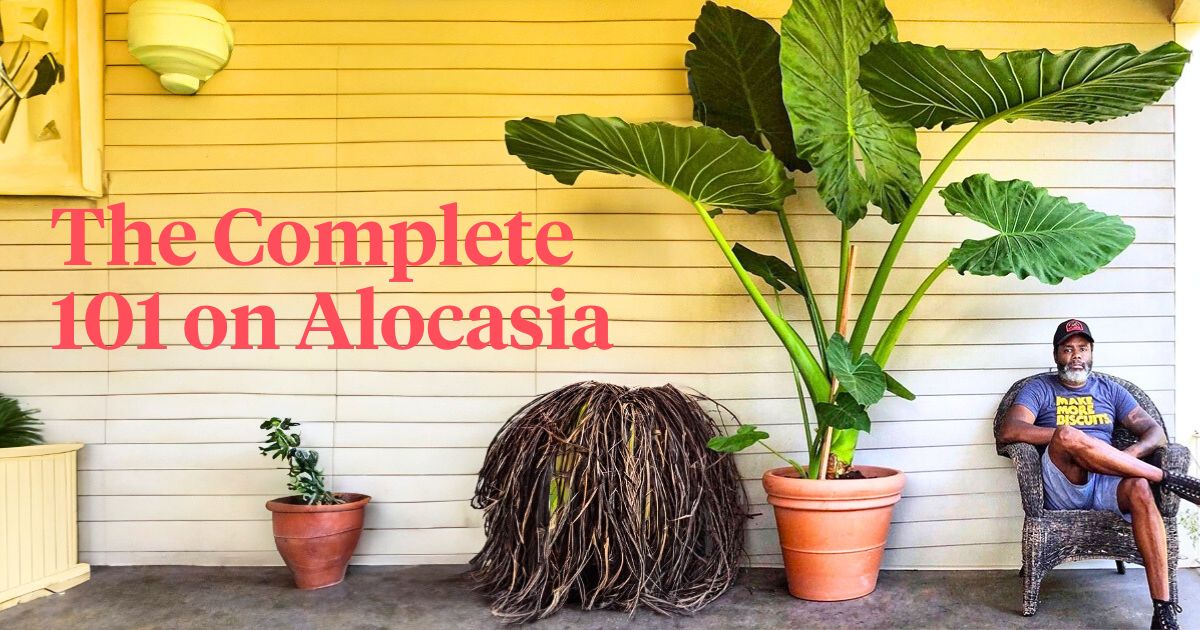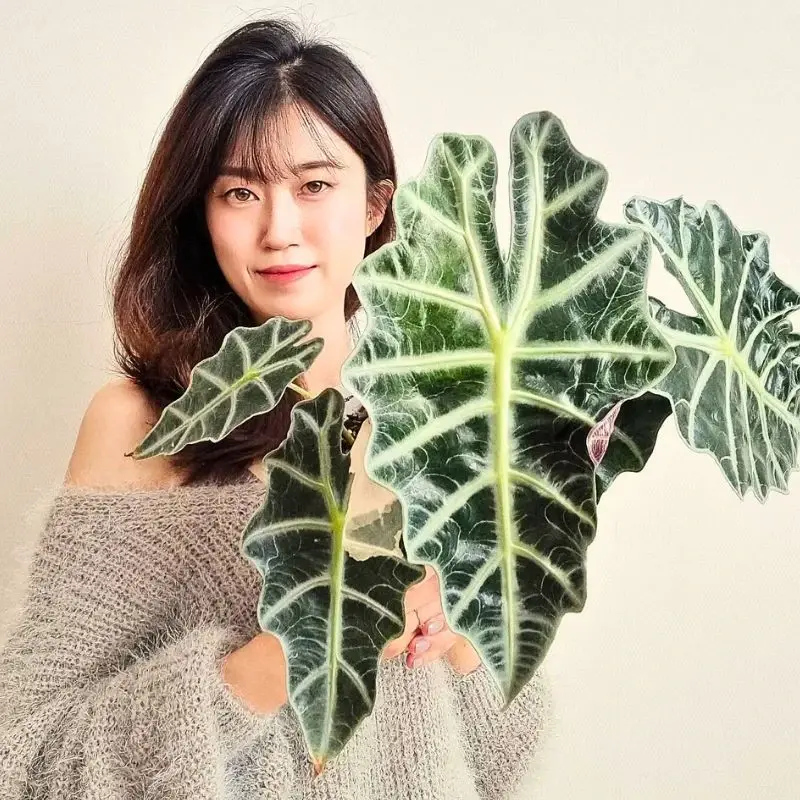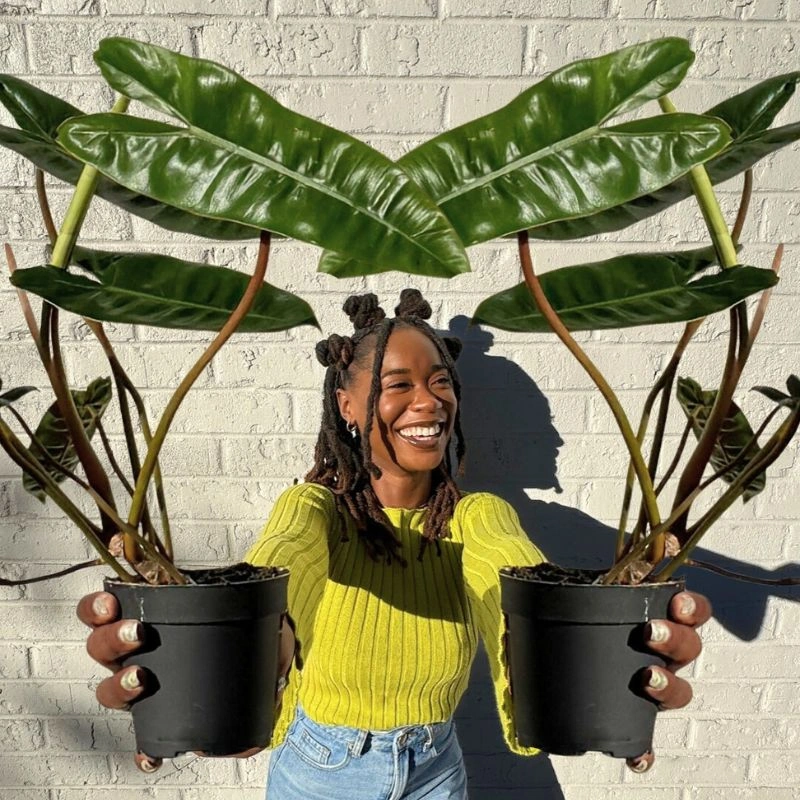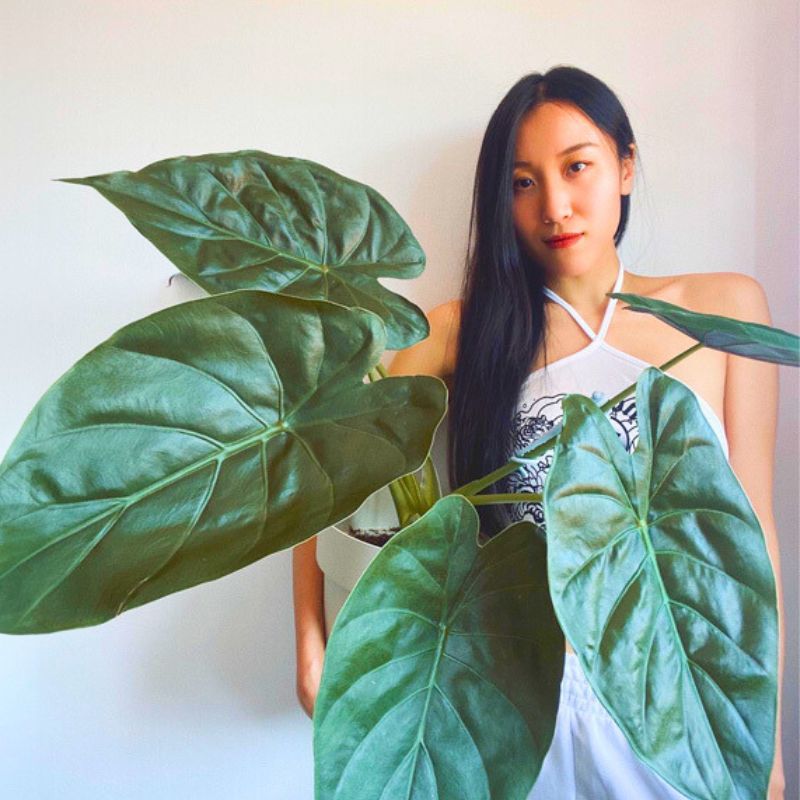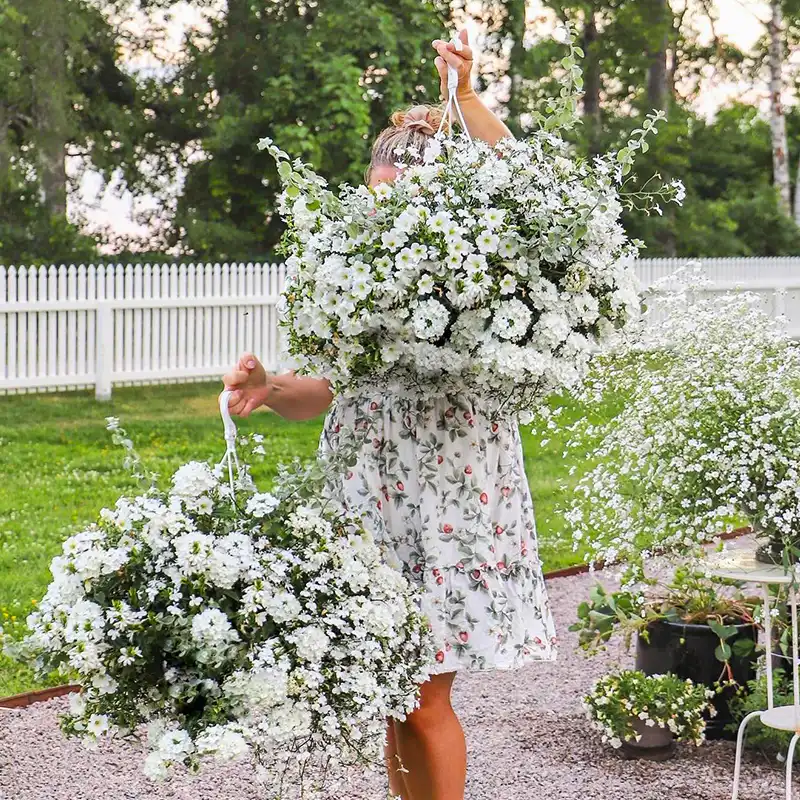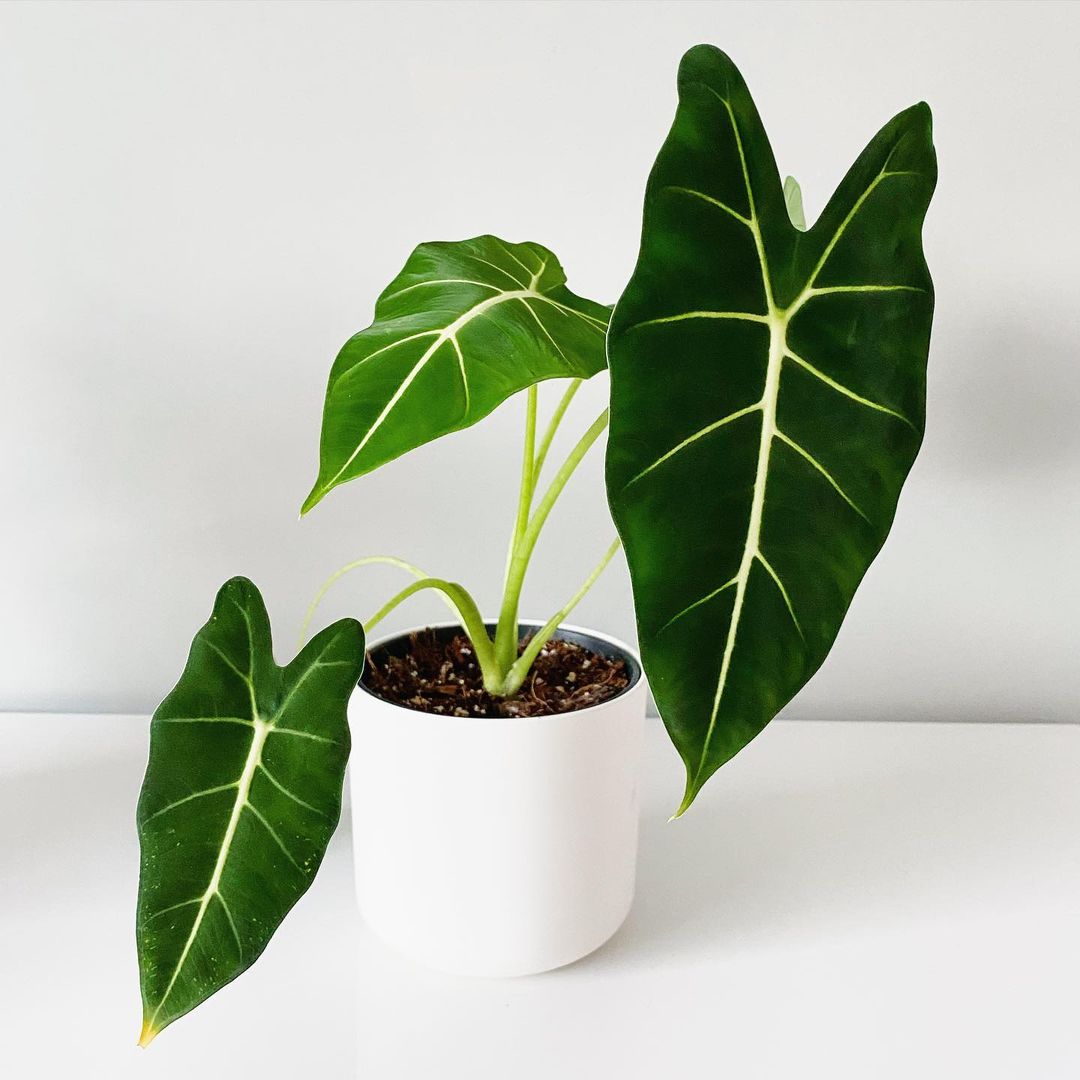The use of Alocasia plants in interior design has grown in popularity due to their exotic appearance and ability to enhance indoor spaces. Their large, lush leaves add a touch of the tropics to any room, creating a serene and inviting atmosphere.
Alocasia plants have become a staple in the world of indoor house plants. Their striking foliage and the diversity in alocasia species makes them a favorite among plant enthusiasts and interior designers. Why? Read this exploration of the fascinating world of alocasia, including their origin, best uses, and care tips to ensure your plant thrives and you can show off your statement alocasia houseplants.
Most Popular Alocasia Spp Varieties
The genus Alocasia is incredibly popular due to its wide range of alocasia varieties. Each alocasia type offers unique features that cater to different aesthetic preferences and care requirements. Whether you're looking for a bold statement piece or a more subdued addition to your collection, there's an Alocasia type for everyone. Some of the most wanted alocasia varieties are:
- Alocasia 'Odora'
- Alocasia 'Polly'
- Alocasia 'Wentii'
- Alocasia 'Amazonica'
- Alocasia 'Black Velvet'
- Alocasia 'Frydek'
- Alocasia 'Jacklyn'
- Alocasia 'Regal Shields'
- Alocasia 'Zebrina'
- Alocasia 'Dragon Scale'
- alocasia 'Yucatan Princess'
- Alocasia 'Silver Dragon'
- Alocasia 'Macrorrhiza Variegata' (Elephant Ear Plant)
Alocasia: Why These Houseplants Are So Popular
This striking houseplant have gained popularity in interior design due to its dramatic leaves and exciting appearance. Their unique shapes and patterns make them a standout choice for adding visual interest to any space. Many alocasia varieties have dark green leaves with prominent veins and/or slightly puckered leaves, often making dramatic contrasts. Additionally, these plants are relatively easy to care for, making them accessible to both novice and experienced home gardeners.

The broad, heart-shaped leaves of this tropical plant create a tropical ambiance, perfect for transforming a dull room into a lush oasis. Their ability to thrive in indoor conditions adds to their appeal, as they can adapt to lower light levels while still maintaining their vibrant foliage. They do very well in a bohemian interior. And many other interiors as well.
Furthermore, the wide variety of these plants means there is a perfect option for every style. From the deep green of Alocasia Polly to the velvety texture of Alocasia Black Velvet, each variety of the different Alocasia types brings something unique to the table.
The Origin of Alocasia and Their Introduction
Alocasia plants are native to tropical and subtropical Asia and Eastern Australia. These regions provide the warm temperatures and humid environments that Alocasias thrive in. The lush, dense rainforests of Southeast Asia are home to many species of Alocasia, where they grow in the understory of larger trees, benefiting from the filtered light and rich, moist soil.
The introduction of these plants to the house plant markets can be traced back to the colonial era when explorers and botanists began collecting exotic plants from around the world. In the 19th century, European botanists such as Joseph Dalton Hooker played a significant role in documenting and introducing these plants to Western horticulture. Alocasias, with their striking foliage and unique appearance, quickly gained popularity among plant collectors and horticulturists. The Royal Botanic Gardens, Kew, in England, became a central hub for the cultivation and study of these exotic plants, contributing to their commercial growth and widespread appeal.

The fascination with Alocasia plants continued to grow, and they soon became a sought-after addition to private collections and botanical gardens across Europe. Their dramatic leaves and exotic origins captivated plant enthusiasts, leading to the commercial propagation and sale of various Alocasia species. Today, these plants are enjoyed by plant lovers worldwide, thanks to the efforts of early botanists and explorers who recognized their unique beauty and potential.
Alocasia Types: Exploring The Diversity
The genus Alocasia boasts a wide range of varieties, each with its own unique characteristics. For instance, Alocasia Odora, also known as Night-Scented Lily, is famous for its fragrant flowers that bloom at night. On the other hand, Alocasia Polly is known for its striking, arrow-shaped leaves with prominent white and deep veining structure.

Alocasia Black Velvet is another popular variety, admired for its dark, velvety leaves that add a touch of elegance to any collection. It's a wanted plant for people who love to have their plants in black! Meanwhile, Alocasia Zebrina stands out with its zebra-striped stems, making it a unique addition to any plant enthusiast's home.

Exploring the various Alocasia plant types can be a delightful experience, as each type offers something different. Whether you're drawn to the dramatic foliage of Alocasia Frydek or the delicate beauty of Alocasia Silver Dragon, there's an Alocasia plant to suit every taste.

In addition to these well-known varieties, there are many other types of Alocasia plants that offer unique features. Alocasia Jacklyn, for example, is known for its intricate leaf patterns that resemble a quilted design. Alocasia Regal Shields, with its large, shield-shaped dark green leaves, makes a bold statement in any room. Alocasia Dragon Scale and Alocasia Silver Dragon both offer striking foliage with textured, scale-like patterns that add a touch of fantasy to your plant collection.

What Causes Variegation in Alocasia Plants?
Variegation in this tropical plant occurs when there is a variation in leaf color, often resulting in patches of white, yellow, or light green leaves mixed with the typical green foliage. This phenomenon is caused by a genetic mutation that affects the distribution of chlorophyll in the plant cells. Chlorophyll is the pigment responsible for photosynthesis, so areas with less chlorophyll appear lighter in color. This genetic variation can occur naturally or be induced through selective breeding, making variegated plants unique and highly sought after.

Why Variegated Alocasias Are So Popular?
Variegated Alocasia plants are incredibly popular among plant enthusiasts and collectors due to their unique and striking appearance. The contrast between the vibrant green and the lighter variegated sections creates a visually stunning effect that adds a touch of elegance and exotic charm to any indoor garden.
Some popular variegated Alocasia varieties include Alocasia Macrorrhiza Variegata, with its large, marbled leaves, and Alocasia 'Stingray', known for its unusual leaf shape and variegated patterns. These plants are often considered statement pieces and can become the focal point of any plant collection:
- Alocasia Macrorrhiza Variegata
- Alocasia 'Stingray Variegata'
- Alocasia 'Frydek Variegata'
- Alocasia 'Dragon Scale Variegata'
- Alocasia 'Maharani Variegata'

Alocasia Care: Tips for Thriving Plants
Caring for Alocasia plants involves understanding their specific needs. These tropical plants require a balance of moisture and humidity to mimic their natural environment. It's essential to water them regularly, ensuring the soil remains moist but not waterlogged.

Watering - Maintaining Moist but Not Waterlogged Soil
When caring for these plants, maintaining the right balance of soil moisture is crucial. These tropical plants thrive in moist conditions, but it’s important to avoid waterlogged soil, which can lead to root rot.
To achieve this balance, water your Alocasia regularly, ensuring that the top inch of soil remains consistently moist. However, make sure to use well-draining soil to prevent standing water. Using a well-draining potting mix, such as one that includes perlite or orchid bark, can help facilitate proper drainage.

Additionally, always check the moisture level by inserting your finger into the soil before watering, and reduce the frequency of watering during the plant's dormant period to prevent soggy soil.
Humidity - Ensuring Humid Environment
Alocasia plants are native to the humid environments of tropical and subtropical Asia, and they thrive in similar conditions indoors. High humidity is essential for their health and growth, as it mimics their natural habitat. To maintain adequate humidity, consider placing your Alocasia in a bathroom or kitchen where humidity levels are naturally higher.
Alternatively, you can use a humidifier to keep the surrounding air moist. Misting the leaves regularly can also help, but be cautious of over-misting, as too much misting can lead to fungal disease. Another effective method is placing a tray filled with water and pebbles beneath the plant pot, ensuring the existing pot is above the water level to provide constant humidity.
Soil - Slightly Acidic Soil with Proper Drainage
The soil composition is vital for the healthy growth of these plants. These plants prefer slightly acidic soil with a pH range of 5.5 to 6.5, which supports nutrient availability and optimal growth. A potting mix specially formulated for tropical plants, containing peat moss, perlite, and orchid bark, can provide the ideal conditions.
Ensuring proper drainage is equally important to prevent water accumulation and root rot. A well-draining potting mix, combined with a pot that has a drainage hole, will allow excess water to escape, keeping the soil aerated and preventing it from becoming waterlogged. Regularly checking and amending the soil composition as needed will help maintain a healthy environment for your Alocasia.
The Light Requirements of Variegated Alocasias
Variegated Alocasia plants require more light than their fully green counterparts due to the reduced chlorophyll content in their leaves. The lighter, variegated sections of the leaves have less chlorophyll, which means they are less efficient at photosynthesis. To compensate, these plants need bright, indirect light to produce enough energy for healthy growth. Providing adequate light ensures that variegated Alocasias maintain their vibrant colors and do not revert to being fully green. Placing them near a bright window with dappled sunlight or using grow lights can help meet their higher light requirements.
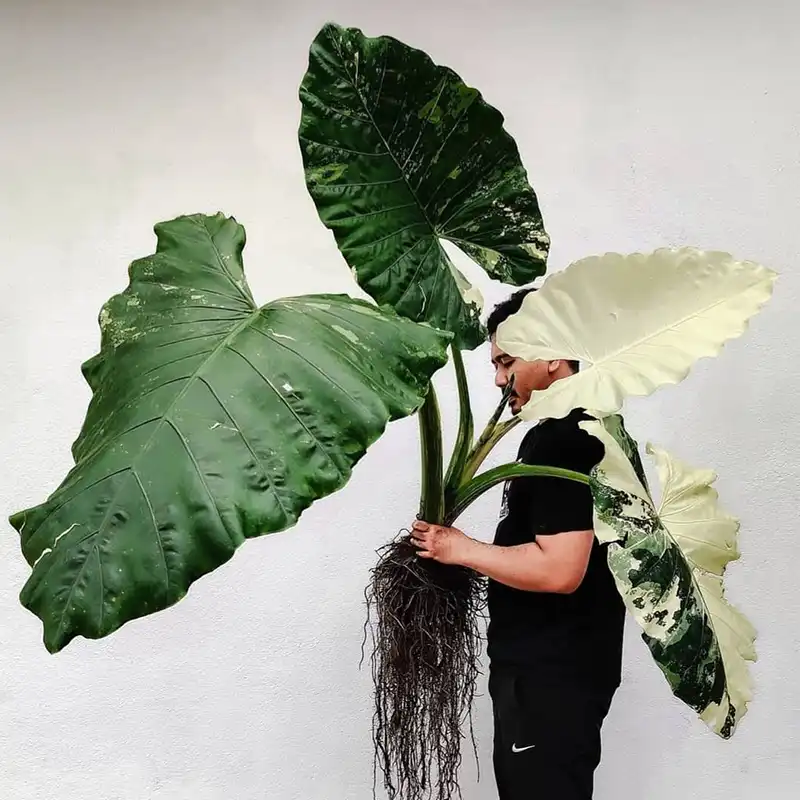
Alocasia Elephant Ear: A Bold Statement Plant
One of the most recognizable varieties is the Alocasia Elephant Ear. Most say the Alocasia Calidora is the one. Others say it's the Alocasia Portodora variety, both having huge leaves. This tropical plant is named for its large, ear-shaped leaves that can grow to impressive sizes. The elephant ear alocasia is perfect for making a bold statement in any indoor garden.
The Alocasia elephant ear plant thrives in similar conditions to other Alocasia varieties. It requires consistent moisture, high humidity, and bright, indirect light to grow to its full potential. Regular feeding during the growing season can also promote healthy growth and vibrant leaves.
.jpg?1718823837414)
With its dramatic foliage and impressive size, the Alocasia elephant ear is a favorite among those looking to create a tropical atmosphere in their homes. Its striking appearance can transform any space, making it a must-have for plant lovers.
Additionally, the Alocasia elephant ear variety includes several subtypes, each with its own unique characteristics. For instance, the Alocasia Macrorrhiza, commonly known as Giant Taro, features enormous leaves that can reach up to three feet tall. Another subtype, Alocasia Portora, has a more compact growth habit but still boasts impressive foliage that adds a dramatic touch to any indoor garden.
Alocasia Plant Care Part II: Maintaining Healthy Growth
Maintaining healthy growth in Alocasia plants involves regular care and attention. Besides watering and high-humidity, fertilization plays a vital role in their development. Using a balanced, water-soluble slow release fertilizer every two to four weeks during the growing season can help provide essential nutrients.
Pruning is another aspect of alocasia plant care. Removing any yellow or damaged leaves can prevent the spread of disease and encourage new growth. It's also essential to keep an eye out for pests such as spider mites and aphids, which can affect the plant's health.
Repotting Alocasia plants every one to two years can also promote healthy growth. Choose a pot that allows for adequate drainage and use a well-draining potting mix to prevent waterlogged soil. Repotting gives the plant more room to grow and refreshes the soil with new nutrients.

Another key aspect of alocasia care is monitoring for signs of stress or disease. Common issues include root rot, which can occur if this tropical plant is overwatered, and leaf spots, which may indicate a fungal or bacterial infection. Treating these issues promptly with appropriate measures, such as adjusting watering practices or using fungicides, can help keep your Alocasia healthy and thriving.
Understanding Water Dripping from Alocasia Leaves - Guttation Explained
When your Alocasia is dripping water from its leaves, it's usually an indication that the plant is slightly overwatered. This process, known as guttation, is the plant's way of expelling excess water through tiny pores on the leaf surfaces. While it might seem alarming, this is a natural mechanism and nothing to worry about—your plant is healthy and just adjusting to its water intake.

However, it's essential to be mindful of where your Alocasia is placed, especially if you have valuable wooden furniture underneath. The water expelled during guttation is slightly acidic and can leave permanent rings on wooden surfaces. To protect your furniture, consider placing a tray or mat underneath the plant to catch any drips, ensuring both your Alocasia and your furnishings remain in excellent condition.
Fertilization and Pruning to Maintain Healthy Alocasia Growth
Alocasia plants are heavy feeders and benefit from regular fertilization, especially during their growing season. Use a balanced, water-soluble fertilizer at half strength every two to four weeks to provide essential nutrients. During the dormant period, reduce the frequency of fertilization to avoid overfeeding.
Pruning is another important aspect of maintaining healthy growth. Regularly remove any yellow or damaged leaves to encourage new growth and prevent the spread of plant diseases. Pay attention to common pests like spider mites and aphids, and address any infestations promptly with appropriate treatments. By combining proper fertilization with regular pruning, you can ensure that your Alocasia remains vibrant and healthy throughout the year.
Is Alocasia Toxic to Cats? Safety Concerns
One important consideration for pet owners is the question: Is Alocasia toxic to cats? Unfortunately, these plants are toxic to cats and other pets if ingested. They contain calcium oxalate crystals, which can cause skin irritation and swelling in the mouth and throat.
If you have cats or other pets, it's crucial to keep this plant out of their reach. Symptoms of ingestion include drooling, vomiting, and difficulty swallowing. If you suspect your pet has ingested any part of an Alocasia plant, contact your veterinarian immediately.

Despite this, Alocasia plants can still be enjoyed safely in homes with pets. Placing the plants in elevated locations or using hanging planters can help keep them out of reach while still allowing you to enjoy their beauty.
It's also helpful to educate yourself about other plants that may be toxic to pets and to create a pet-safe environment. By taking precautions and being aware of the potential risks, you can enjoy the beauty of these plants while keeping your furry friends safe.
Alocasia in Interior Design: Bringing the Tropics Indoors
The use of Alocasia plants in interior design has grown in popularity due to their exotic appearance and ability to enhance indoor spaces. Their large, lush leaves add a touch of the tropics to any room, creating a serene and inviting atmosphere.
Interior designers often incorporate these plants into various design styles, from modern minimalist to bohemian chic. Their versatility makes them a great addition to living rooms, bedrooms, and even bathrooms. Placing an Alocasia plant in a decorative pot or basket can elevate the aesthetic of the space and make it feel more connected to nature.
Additionally, the architectural structure of these plants makes them an excellent focal point in any room. Their bold, statement-making leaves draw the eye and can serve as a natural centerpiece. Whether placed on a plant stand, a shelf, or directly on the floor, these plants add an element of drama and sophistication to interior design.
Another advantage of incorporating these plants into interior design is their air-purifying qualities. Like many other houseplants, Alocasia plants can help improve indoor air quality by removing toxins and increasing humidity levels. This not only enhances the aesthetic appeal of a space but also contributes to a healthier living environment.

Propagating Alocasia: Expanding Your Collection
Propagating Alocasia plants is a rewarding process that allows you to expand your plant collection and share these beautiful plants with others. There are several methods of propagation, including division and stem cuttings.
The most common method is division, which involves separating the plant into smaller sections, each with its own root system. This is best done during repotting, when the plant is already being removed from its pot. Carefully separate the root ball into two or more sections, ensuring each section has a healthy amount of roots and leaves. Plant each section in its own pot with fresh soil, and care for them as you would a mature Alocasia plant.
Stem cuttings are another method of alocasia propagation. This involves cutting a healthy stem with at least one leaf and a portion of the rhizome (the underground stem from which roots and shoots grow). Place the cutting in a container with water or directly in moist soil. If using water, change the water regularly to prevent stagnation. Roots should begin to develop within a few weeks, after which the cutting can be planted in soil.
Propagating Alocasia plants not only allows you to grow more plants but also helps to rejuvenate older plants. Regular propagation can prevent the plants from becoming too crowded and improve overall growth and health.
Alocasia and Their Unique Characteristics
One of the reasons most Alocasia plants are so beloved is their unique and varied characteristics. Each variety offers distinct features, from leaf shape and color to growth habits and size. This diversity makes these plants a fascinating and dynamic addition to any plant collection.
For example, Alocasia Polly, with its striking white veins and glossy leaves, provides a dramatic contrast to the slightly deeper, velvety texture of Alocasia Black Velvet. Similarly, the bold, zebra-striped stems of Alocasia Zebrina offer a unique visual appeal compared to the quilted, dragon-scale-like leaves of Alocasia Dragon Scale.

Understanding and appreciating the unique characteristics of each Alocasia variety can enhance your enjoyment of these plants. By selecting different varieties, you can create a diverse and visualy stunning indoor garden that showcases the wide range of forms and colors found within the genus Alocasia.
Furthermore, learning about the specific care requirements and preferences of each variety can help you provide the best possible environment for your plants to thrive. Whether you are drawn to the dramatic foliage of Alocasia Frydek or the elegant simplicity of Alocasia Silver Dragon, each plant brings its own charm and beauty to your collection.

The Beauty of Alocasia Plants Is Something Everyone Experiences
In conclusion, Alocasia plants offer a unique blend of beauty and variety that makes them a standout choice for any indoor garden. Their diverse range of types and striking foliage make them a popular option for both interior design and plant enthusiasts. They are everyone's favorite.
By understanding the specific care requirements of Alocasia plants, you can ensure they thrive and add a touch of tropical elegance to your home. Whether you're drawn to the bold heart-shaped leaves of the Alocasia Elephant Ear or the delicate charm of Alocasia Polly, there's an Alocasia plant for everyone.
With proper care and attention, these plants can flourish and bring joy to your indoor garden for years to come. So, why not embrace the beauty of Alocasia and add one (or more) to your collection today?
Header and featured image by @cedricsmithstudio

